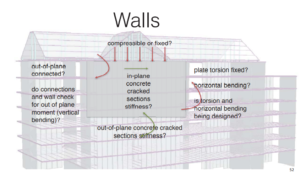Stiffness Modifiers in FEM
How do you establish appropriate cracked section factors for your structural elements when modeling reinforced concrete structures? Do you typically follow ACI, assume everything is cracked, run the model, and call it a day? How can you be sure the stiffness modifiers you selected for your structural elements mimic reality?
In the September 2022 SEU session, Sam Rubenzer, PE, SE, from FORSE Consulting, presented Verifying Software Results to our SEU group. Sam explained some methods used in software for load generation and how to verify their accuracy. He showed how to develop methods to determine what to expect from analysis results and ways to create checklists to assist with finding modeling or analysis errors. He also covered code checks performed by software programs and highlighted items that are not checked.
Sam noted that a prudent approach to verifying software results includes establishing simple models to approximate results and then moving toward a more complex product to compare with the original model results. For engineers using finite element modeling for reinforced reinforced concrete buildings, this task involves assigning effective stiffness factors for various structural elements. Some engineers assign the same cracked factors based on element type, but this simplification could be inaccurate in some instances. Sam recommended an article which identifies the importance of establishing accurate cracked section factors during analysis. Effective Stiffness for Modeling Reinforced Concrete Structures, by John-Michael Wong, PhD, SE, Angie Sommer, SE, Katy Briggs, SE, and Cenk Ergin, PE, appeared in Structure Magazine in January 2017. Within the article, a useful table presents the various stiffness modifiers for elements for many different building codes throughout the world. This table highlights the complexity that is inherent in attempting to accurately model these structural elements in analysis software and how a more detailed level of thought is required to produce an accurate building model.
The following slide shows one example from Sam’s presentation of a building wall and the many considerations that should be taken when modeling. What is the purpose of the wall? Is it being used more in bending, shear or axial? Sam noted the engineer should consider the fixity, bracing and purpose of the element when modeling in software and some elements may need varying stiffness factors for in-plane and out–of-plane loads.
Since cracked section factors significantly affect the results of software analysis, engineers need to understand the importance of selecting appropriate factors for their structural elements. This process can be iterative since the assumed stiffness of various elements influences the dynamic response of the structure and can change the results of the analysis and the effective stiffness. As Sam suggested, moving toward a more complex model that mimics reality should be a reasonable exercise, however, modeling an exact replica with each element having a unique cracked section factor would be inefficient. This article offers guidance from various building codes on appropriate cracked section factors and should be a quick reference when developing complex finite element models.



There are no comments yet, but you can be the first